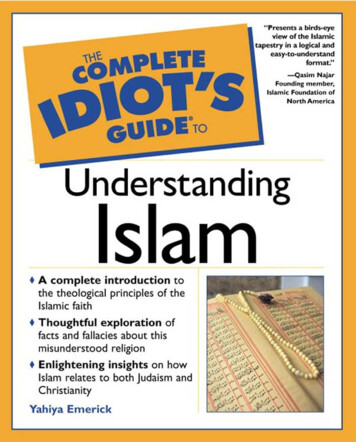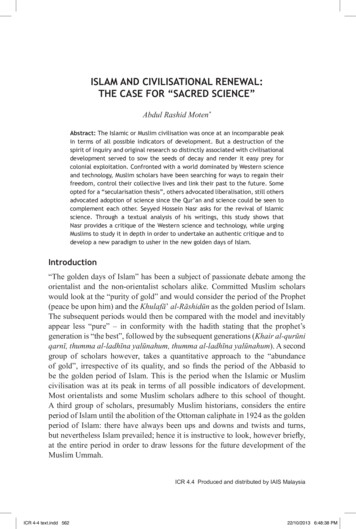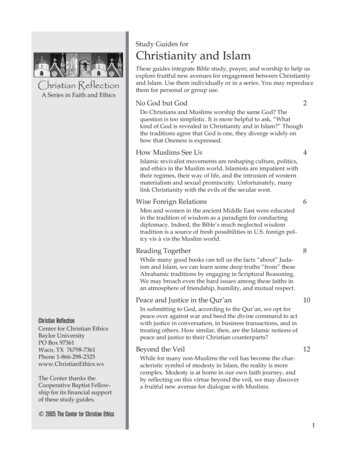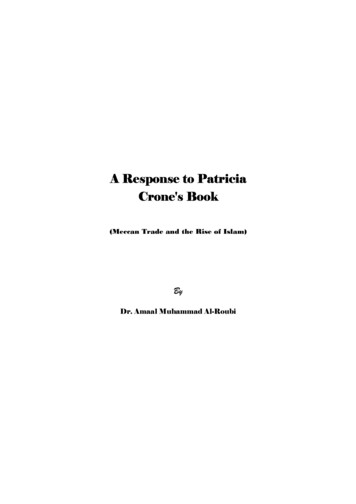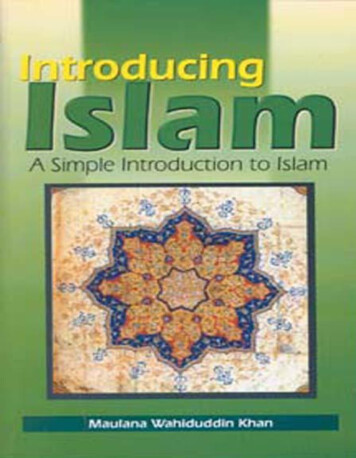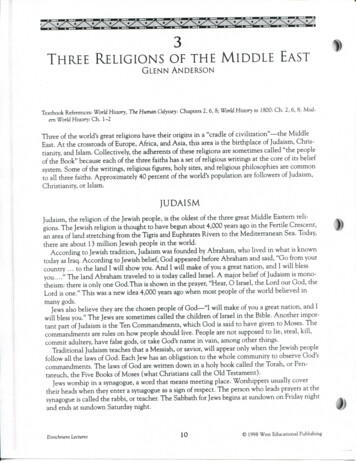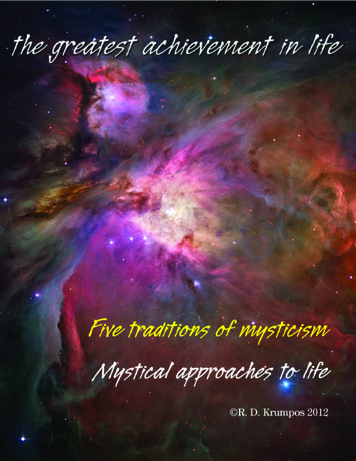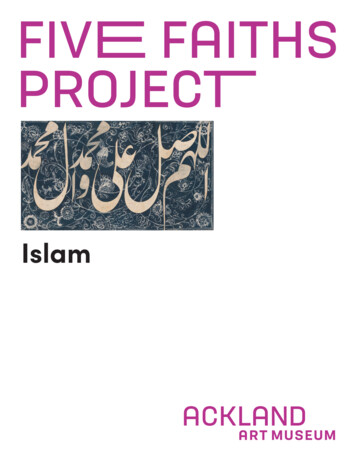
Transcription
Islam
Table of ContentsIntroduction to Islam. 2In the beginning, Allah. 2The life of Muhammad . 2The Meaning and Purpose of Islam . 3The Five Pillars of Islam: Declaration of Faith, Prayer, Fasting, Charity and Pilgrimage . 4The all-encompassing nature of the teachings of Allah . 6Two streams of Islam: Sunnis and Shi’ites . 6Growth of Islam. 7Muslims United in Prayer . 7Further Research & Points for Discussion . 8Panel of Calligraphy, n.d. . 10Devotional Book, 1769 . 12Watch and Compass, late 19th century . 14Voices of Faith. 16Bismilla . 16The Story of My Name . 19A Story of Muhammad . 24Muhammad Ascends to Heaven. 26A Story of Piety . 31Glossary . 33 Ackland Art Museum: “Five Faiths Project” resources created by museum education staff, 1995 - 2005
Introduction to IslamIn the beginning, AllahWhat God grants to people out of His mercy, no one can withhold, and what Hewithholds no one can grant apart from him. And He is the Powerful, the Wise.Qur’an 35:2According to Islamic teachings about the nature of God recorded in the sacred text, theQur’an, Allah literally means The God, not a god, not one of many gods, but the one andonly God. Allah created all that exists, heaven and earth. Allah created human beings, thefirst man, Adam, and the first woman, Eve. According to the teachings of Islam, Adam wasnot only the first human, but also the first of Allah’s prophets. From time immemorial, Allah hasspoken through his prophets, also referred to as messengers, reinforcing, renewing andrefining the same basic message to all humankind. Allah is and has always been the sourceof all things, and peace is achieved through surrender to Allah.According to sacred texts, one of the descendants of Adam was a man named Abraham.In Islam, he is one of the prophets of God. Abraham was faithful to Allah. Allah promised himthat he would be the progenitor of a great nation. Abraham had two sons. His first son henamed Ishmael. Ishmael was the child of Hagar. His second son, the child of Sarah, wasnamed Isaac. Sarah demanded that Hagar and Ishmael leave Abraham’s household.Ishmael went to the place later called Makkah (sometimes transliterated as Mecca). Thedescendants of Ishmael, directly connected to Abraham and Hagar, became Arabs. Fromthe line of Isaac, Sarah’s son, came the Hebrew people, later called the Jews.The life of MuhammadCenturies later, in Makkah, the prophet Muhammad was born in 570 CE. His name means“the praised one.” The world into which Muhammad was born was filled with difficulty. Withindays of his birth, Muhammad’s father died. His mother died when he was only six. For thenext two years, his grandfather cared for him, but he also died when Muhammad was onlyeight. He went to live with the family of his uncle. He had to work hard in his new family inorder that they might all survive the harshness of life in the desert. He tended his uncle’sflocks and grew up in a world filled with conflicts between tribes and cities filled with strifeand thievery. When Muhammad reached adulthood, having married and established hisown household, he began to search for answers to the problems of humanity and thepurpose of life.On a night commemorated as The Night of Power, while Muhammad was engaged inworship in the cave named Hira, his usual mountain retreat, all of creation grew very still.Amid the stillness, a voice spoke to Muhammad and told him he was the appointed one, theone who would bring Allah’s message to the world.The angel Gabriel spoke to him, saying, “Read.” Muhammad answered that he did not knowhow to read. The angel embraced him, holding him tight. When he released him, the angelsaid again, “Read.” Again, Muhammad answered that he could not read and again the
angel held him tight. Finally, on the third exchange, Muhammad began to recite the firstrevelation of the Qur’an. He rushed home to tell his wife, Khadijah. Muhammad’s life wasforever changed. God had commanded that he preach the message to a world in need ofthe instruction. The recorded events of Muhammad’s life say that he did all that he wascommanded to do.The teachings that God gave to Muhammad were recorded in Arabic, in a collection calledthe Qur’an. The Qur’an contains the divine words revealed to Muhammad through theangel Gabriel. Within the Qur’an are the stories of the faith, stories of 25 of the manyprophets who went before Muhammad and the stories of the life of Muhammad, the last ofAllah’s prophets. Muslims believe that the Qur’an faithfully and perfectly records all thewords which God spoke to Muhammad. The Qur’an is written in Arabic. While the meaningof the Qur’an has been rewritten into languages other than Arabic, it can never beaccurately translated because it contains the exact words of God. The words themselvesare divine and unalterable. Arabic is the language through which these sacred truths wereand will always be communicated.On the opening pages of this sacred text, Muslims find the first truths of Islam and the textbears the seal and blessing of God. This guarantees to Muslims that the text is complete,accurate and true. Muslims believe that the Qur’an constitutes the one true and completeguide for Muslims, and the revelation of the life of Islam.The Meaning and Purpose of IslamLiterally, Islam means “peace achieved through surrender to God,” and a Muslim is one whostrives to surrender in that way. The ultimate goal of all Muslims is to live a life of absolute andcomplete devotion to the will of God, following in the teachings of his prophet, Muhammad.In order to become a Muslim, one must make a true and heartfelt profession of faith,preferably in the presence of another faithful Muslim. This profession is more than the sayingof the words but is seen as the living expression of deeply held beliefs. The profession says““La ilaha illallah, Muhammadur rasool Allah” – “There is no deity except God, Muhammad isthe Messenger of God.”” To make this profession is to affirm and accept the Islamic beliefthat there is only one God, only one Creator, Ruler and Supreme Authority. It is important tobe very clear that Muslims believe that Allah is not a specific tribal god, but rather, is the OneGod, whose name in Arabic and in the Qur’an is Allah. Islamic tradition acknowledges thatAllah is the same God recognized by all the prophets and followers of monotheistictraditions.In order to understand how to surrender to the will of Allah, Muslims look to his messengers.Islam affirms the role of the prophets who came before Muhammad: Abraham, Moses,Isaiah and Jesus. Muhammad delivered the final message of God’s will: All of life must belived with an understanding of the will of Allah. To do so will bring understanding, dignity,compassion and meaning to human life in this world, and salvation in the Hereafter. Inaddition to devotion to Allah, Muslims also hold an abiding regard for the humancommunity. In Islam, all faithful actions honor Allah and support the common life of humanbeings.
The Five Pillars of Islam: Declaration of Faith, Prayer, Fasting, Charity and PilgrimageThe core beliefs and practices of Islam are called the Five Pillars. These five pillars support thewhole of Islam. Each pillar expresses an aspect of the nature of Allah and the individual’snecessary response. Allah is the Ultimate Reality, unknown to finite minds, but explained inthe revealed words of the prophets. The prophets teach that God created human beings asthe one creature gifted with a mind capable of thinking, reasoning, remembering andteaching ideas to others. In addition, human beings are uniquely gifted with a feeling heartand are the recipients of free will. By that, Muslims mean that human beings are not limitedto instinctual behaviors, but rather are free to choose a path rooted in the spiritual truths heldin the Qur’an. The Five Pillars are given in the Qur’an. Sunnah, the other sacred text forMuslims, is the collected sayings, called Hadith, actions and approvals of the ProphetMuhammad. The Sunnah offers Muslims necessary instructions for the practice of Islam. Forexample, the Qur’an says that all Muslims are to pray five times a day and a Hadith instructsin how one should pray. The First Pillar (SHAHADAH) is the declaration of faith: “There is no deity except God,Muhammad is the Messenger of God.” All Muslims make this statement with a believingheart. This declaration establishes the core truth of Islam. The remaining four pillars offer away of life by which all Muslims may honor Allah. The Second Pillar (SALAH) is Prayer. Five times a day, Muslims stop their regular activities toturn their attentions directly to Allah. Islamic prayer is distinct from other traditions in that itis a multifaceted activity, including bodily postures, standing, bowing, lying on the groundand sitting, each repeated during the prayer. Muslims face Makkah during times ofprayer. Prayers include recitations from the Qur’an. Praise and petitions are also includedwithin Salah. This rhythm of prayer helps all Muslims to maintain their awareness of Allah,their devoted commitment to live their lives according to his commandments. Just beforesunrise, at noon, in the late afternoon, at sunset and in the evening, Muslim’s reach out toAllah in prayer. So important to the faithful life is this discipline of prayer, that it is practicedeven in times of great difficulty or illness. Special accommodations are made for those forwhom bowing, for example, might be physically impossible. Salah is a regular expressionof each individual’s commitment to Allah and dependence on Allah’s mercy. On Fridays,Muslims gather for community prayers at the mosque, the sacred gathering place. The Third Pillar (SAWM) is Fasting. One of the strengths of Islam lies in its willingness tounderstand and honor human needs. All people have need of food and water. Marriedcouples have a need for sexual intimacy. But none of these needs must guide the life of aMuslim. Even our most basic human desires must come under the discipline of Allah. Tothat end, fasting is a part of Islam. During the month of Ramadan, the ninth month of thelunar Islamic calendar, Muslims are asked to go without food or drink, even water, andsexual relations from dawn to sunset. The final ten days and nights of Ramadan are filledwith rigorous prayers and devotions, including the commemoration of the Night of Power.Throughout the month, Muslims, by their fasting, are given the chance to deepen theirawareness and heighten their devotion to Allah. By turning away from the satisfaction ofhuman, physical needs, Muslims connect more deeply with the community. In the fasting,
Muslims remember again the needs of others, the hunger of the world and the longing ofthe human heart for Allah. While Muslims value generosity at all times during the year,they also strive to practice greater generosity in the month of Ramadan.The believer is not the one who eats his fill when his neighbor beside him is hungry.The Prophet Muhammad The Fourth Pillar (ZAKAAT) prescribes the acts of charity which are essential in Islam.Zakaat has no true equivalent in the English language. It may be understood aspurification, but it has more to do with charity, with remembering the poor and givingthem their due than the word purification might imply at first reading. The Fourth Pillarconstitutes the free giving of a percentage of one’s assets to the poor, to the sick andneedy and to the causes of God for the construction of mosques, schools and hospitals.While the percentage is established at 2.5 percent, each Muslim must annually assess hisholdings and property. Zakaat is paid only on holdings above and beyond that which isneeded for basic survival. Zakaat is paid after debts and other financial obligations. Inother words, Zakaat is never to be seen as an excuse not to care for one’s household, noris it to be an excuse to default on other financial responsibilities. Rather, it is a reminderthat all wealth belongs to Allah. Muslims believe that in giving away a mere 2.5 percent,the remaining possessions and assets receive Allah’s blessing. This giving aids in the careof all Muslims and others. Zakaat does not constitute the whole of Muslim charity. Beingresponsive to human need, seeing one’s wealth as a gift from Allah and sharing what onehas with others are central practices in Islam. The Fifth Pillar of Islam (HAJJ) is Pilgrimage. At least once in the life of every adult Muslimwho is financially, physically and emotionally able to make the journey, a pilgrimage toMakkah is required. The journey is carefully prescribed. Hajj is made during the month ofDhul-Hijjah in the Islamic lunar calendar, between the seventh and tenth days of thatmonth. At each step of the journey, prayers are said, and rites performed which expressthe devotion of the Muslim. Men wear special garments made out of unstitched whitecloth. Women can wear any dress that meets the Islamic guidelines of modesty. Pilgrimsrefrain from intercourse with their spouses, do not adorn themselves with perfume and areinstructed never to quarrel or be obscene in any way while they make this pilgrimage.Upon arrival in Makkah, after finding housing and food, pilgrims visit the Kabah, theSacred House. Originally, Abraham and Ishmael built the structure as the first site ofworship to Allah. The building, which is in Makkah, has been rebuilt many times, but atleast one stone remains from that original building. It is called the Black Stone andbelieved to have come from Paradise. Some say that the stone is part of a meteorite. Asthe pilgrim circles the Kabah, special prayers are spoken in the manner described byMuhammad. While touching the stone is not a requirement, many pilgrims hope to do soas a reminder of the love the pilgrim feels for Allah. After circling seven times, the hajjcontinues with other actions. Washing in the underground well spring of Zamzam, andhastening between two nearby hills, each and every action reminds the Muslim of theloving nature of God, their voluntary rejection of evil and idolatry and their devotion tothe teachings of Allah. By shared participation in common rituals, the hajj serves as areminder of the vastness of the Muslim community and deepens the individual’s sense ofbelonging, of being part of a single, whole community spread throughout the world.
The all-encompassing nature of the teachings of AllahBut Islam is not limited to these five pillars, for part of its strength lies in the all-encompassingnature of the teachings. Every aspect of human discourse is discussed. Every concernaddressed. Muslims believe that Islam is a religion, yes, but it is also a complete way of life.The sacred texts contain a strong love of learning, encouraging Muslims to study. Highlydeveloped systems of mathematics, geometry and medicine all emerged in Islamic culturefar in advance of the rest of the civilized world. While Muslims regard Muhammad as the truemessenger of Allah, he is never seen as the center of the faith. Muslims look to the suras(passages comparable to chapters) in the Qur’an and the Sunnah for divinely inspiredinstructions for every aspect of Islamic life.Islamic teaching establishes the Qur’an as the collected recitations of Allah and the one truemiracle of Islam. Therefore, whenever the Qur’an is read, Muslims hear Allah speaking.According to one source:Mystics have chanted and sung, meditated upon, and esoterically interpreted theQur’an; grammarians have based rules for Arabic on it; legists and theologians haveformulated guidelines for all of life in light of it; artists have embellished almost allIslamic buildings and artifacts with its words in elaborate calligraphy; conservators ofthe status quo have claimed it as their authority; reformers have built movementsaround a return to its preaching; and ordinary people have patterned their lives aswell as their speech after its words.In the Islamic tradition, the Qur’an is understood to cover every aspect of Muslim life, and todo so without error.Two streams of Islam: Sunnis and Shi’itesOur confidence, O Lord, is in you and your unlimited mercy and compassion.from Prayer for Istesquaa, a prayer for rainSince the coming of the Qur’an and the teachings of the Muhammad, over time, Islamdivided into two main streams, Sunnis, or Traditionalists, and Shi’ites, or Partisans. TheTraditionalists comprise the overwhelming majority of Muslims in the world today. While thereis some divergence, both hold to the significance of the Five Pillars and other majorteachings. Islam also has a mystical tradition, known as Sufism. Sufis find a great wealth ofexperience available by drawing a distinction between the inner and outer worlds, betweenthe Ultimate Reality of Allah and the present reality of this world. They pursue the mysteries oflove, ecstasy and intuition. Each of these mysteries offers new ways to understand themystery and love of Allah. Sufism expresses itself in remarkable love poetry, understanding allloves between human beings to be mere shadows of the love of Allah. In ecstatic states,trances and other deep meditations, Sufis experience transcendence, journeying outside thenormal world and into the spiritual realm. They consider this to be in keeping withMuhammad’s Night Flight, when all the layers of heaven were revealed to him. Sufis do notclaim to see what he saw, but rather to approach it. In intuition, Sufis give attention to eyesof the heart, acknowledging that the whole world is God in disguise.
Sufism sees all aspects of devotion as important and necessary but also contends that thecompliance with all these aspects is symbolic of the self’s deepest spiritual need to removeall obstacles and barriers which exist between one and God. By continual invocations andrecitations, the heart is polished and made ever more beautiful. Nevertheless, Islam is areligion of moderation, maintaining that spiritual exercises should not be cultivated at theexpense of moderation in sleeping, eating, praying or any communal activities for religiouspurposes. While there has been and remains a certain level of conflict between thetraditions of Islam, there is agreement that there is no God but Allah and the Qur’an is therevealed word of Allah.Growth of IslamHistorically located in the lands surrounding Makkah and comprising Arabia, Islam is nowpresent in virtually every country on earth. One in five or six people alive today are practicingMuslims. Whether by conversion or by birthright, they choose to live according to theguidance of the Qur’an. Were there time in this text to study the historical impact of Islam, itwould not take long to note that while most of Europe lay dormant during the Dark Ages,Muslim philosophers and scientists, artists and architects were busy, moving thought,mathematics, and architecture forward. Their influence is seen in our modern medicine,architecture and literature.Muslims United in PrayerBy turning to prayer, Muslims all over experience their unity. Muslims pray as a regularreminder and expression of their relationship to Allah and to the community of faith. Theymay gather in mosques, or pause alone during the business of the day, listen to the call toprayer from a nearby minaret, or to the radio broadcasts of prayers. They may be in theprivacy of their homes. Following specific prayer and worship forms, they call out to Allah formercy, for grace, for courage. They praise Allah for compassion and generosity. They givethanks for Muhammad and his devotion to Allah. So great is their appreciation of theProphet Muhammad that every mention of his name, either orally or in writing, is followed bythe words “May God’s peace and blessings be on him.” At any time of the day or night,somewhere on earth a Muslim is saying prayers. The times of prayer circumnavigate theearth just as the path of the sun covers the earth. As they pray, close to a billion people,each, in their way, determines anew to live within the intricate life code of Islam in order toexpress full devotion to Allah. Each is hearing a passage and remembering the words of theQur’an. One such passage illuminates the Muslim love for Allah:God! There is no deity except Him, the Living, the Eternal. No slumber can over powerHim, nor sleep. His are all things in the heavens and on earth. Who is there who canintercede in His presence except as He permits? He knows what is before them andwhat is hidden from them, and they cannot comprehend anything of His knowledgeexcept what He will. His kingdom spreads over the heavens and the earth, and theguarding of them does not weary Him, and He is the Exalted, the Almighty.(Qur’an 2:255)
Further Research & Points for Discussion The Qur’an, the sacred text of Islam, is maintained in Arabic. It is understood that Arabiccontains within it the teachings and precepts of Allah. Any translation will lose meaning. Askstudents to consider what words are in common usage in America which would not easilytranslate into other languages. Can they think of words which have been wholesaletransplanted into American speech from other languages? Why might a religion want to keepits original language? Locate Makkah (Mecca) on a world map. Using travel agents and other resources, askstudents to plan a trip to Mecca. How would they get there? What could they expect that thistrip might cost? What are the climate and the terrain of this part of the world? What wouldthey have to pack for such a journey? Remind students that no one is encouraged to makethe pilgrimage to Makkah unless their family’s needs are met. Ask students to consider the Muslim practice of Zakah. Make a list of all your possessions andyour assets, including money in your savings account and in your pocket. Attach a fairmonetary value to your possessions. Add all the figures to find your net worth. Determine whatconstitutes 2 1/2 percent of your net worth. Put the findings on a piece of paper. Do notinclude your name. Gather all the amounts and determine how much your classroom wouldbe able to give if you were to give these 2 1/2 percent to the poor. Remind students thatsomeone who has only enough to meet their own and their family needs is not required togive the 2 1/2 percent. Ask students to consider how this practice, one of the Five Pillars ofIslam, may be a just way to distribute to the needs of the poor. The Muslim calendar is based on the cycles of the moon. Ask students to research the moon’scycles and the Muslim calendar. Using the library and the Internet, as well as other resources,determine what month the class is currently in according to the Muslim calendar. And also,what year is it? Because Ramadan is a month-long season, which requires day long fasting, based on thelunar calendar, how many hours of fasting would an American Muslim fast if Ramadan fell inthe summer? In the winter? Even without knowing all of the religious reasons for fasting, askstudents to consider what benefits they can imagine from regular fasting. Some students maywish to consider the difference between being “hungry” and “not being full.” How often doAmericans eat just because they are bored or because it is time to eat? Students may wish toask family members and friends if they have ever fasted. For what reasons? What was it like?Teachers may wish to caution students about the problems of fasting. The goal of Ramadan isnot to injure anyone, by denying them food or water, but rather to increase devotion andawareness of the needs of others. The Muslim code of behavior is based on the belief that Allah is interested in all aspects ofhuman life. Decisions made about how to spend one’s time, money and energy are allinformed by the love of Allah. Ask students to consider how families and individuals determinehow to spend their resources. In American society what codes of behavior are we expectedto honor? Why?
Muslim artisans were skilled in calligraphy and tile making. Many buildings in the Muslim worldare highly decorated with mosaics. Students may wish to design a mosaic pattern which isconsistent with Islamic traditions (see Strategies for Viewing Islamic Art) or with their own beliefsand traditions. Mosaic tiles are available in art supply stores. Students might also use coloredpaper cut into tiny squares to complete the project.Contemporary Research Options There are more than a billion Muslims worldwide. What are the countries in which Islam is thedominant religion? Where is it growing? Islam is the fastest growing religion in the world today.How many Muslims live in America today? Are there Muslims in your community? Where is thenearest Mosque? Given that Islam offers followers a way of organizing their whole lives in devotion to Allah, whatproblems might a Muslim family face in contemporary American society. Remember that insome Muslim families, dress codes are a normal part of life. Students may also wish to considerthe difficulties a Muslim student might face at noontime, when prayers are normally spoken.How would you feel if you wanted to stop for prayer during a school lunch? What might makethat difficult for you? Would you do it anyway?
ISLAMPanel of Calligraphy, n.d.Attributed to Shamsuddin Asaf Jahi (Indian, Deccan, Hyderabad: Katabahu, active 1724-1748)Paper appliqué and white opaque watercolor on dark blue paper; 5 3/8 x 9 3/16 inBecause Arabic is the language in which the angel Gabriel spoke to Muhammad, revealing themessage of Allah, the letterforms of Arabic play a significant role in Islamic art. The letterformsthemselves are considered to be uniquely able to contain Allah's teachings, and have the capacityto communicate sacred truths.For Muslims, merely looking at the forms, is an act of devotion. Speaking the words, even without fullunderstanding, may also be employed as a religious practice and discipline.In this piece, the letterforms have been placed on a background of flowers and vines. The gardenimagery is considered to be a symbol of paradise. While Islamic art does not contain images of Godor of the prophet Muhammad, because idolatry is forbidden, it is common to see the names of Allahand the name of the prophet. The calligraphy says:"God bless Muhammad, and the family of Muhammad"
Attributed to Shamsuddin Asaf Jahi (Indian, Deccan, Hyderabad: Katabahu, active 1724-1748); Panel of Calligraphy, n.d.; Paper appliqué andwhite opaque watercolor on dark blue paper; 5 3/8 x 9 3/16 in.; Ackland Art Museum, The University of North Carolina at Chapel Hill, Gift of CharlesMillard, 91.75
ISLAMDevotional Book, 1769North African, AlgiersPaper, gold leaf, ink, watercolor; leather binding, 6 5/8 x 4 1/2 inThe illuminated pages in this image come from a Muslim prayer book. Prayer is a regulardiscipline in Muslim life. Five times a day, Muslims pause from their daily activities in order toface in the direction of Makkah and pray. In this work, students may see two buildingssurrounded by courtyards. The page on the right depicts the mosque surrounding the Ka'ba inMakkah, which plays a central role in the ritual life of Muslims. Built by the Prophet Abraham asthe first shrine for the worship of God, the Ka'ba orients Muslims in their daily prayers and is thefocus of their hajj (pilgrimage). The page on the left depicts Muhammad's tomb and mosquein Medina.In contemporary Makkah, the Ka'ba still stands, along with a Grand Mosque. During theannual pilgrimage to Makkah, more than two million Muslims gather at this place.Islamic law prohibits images of Allah and discourages images of the Muhammad. Illustrationsof centers of worship are not uncommon. The artist has included suggestions of thesurrounding terrain.In 605, the Ka'ba was rebuilt by several tribes in Makkah. When it came time to replace thecornerstone, the rock thought to be made from a meteorite, the tribes could not agree on whoshould be the one to replace it. Wh
understand and honor human needs. All people have need of food and water. Married couples have a need for sexual intimacy. But none of these needs must guide the life of a Muslim. Even our most basic human desires must come under the discipline of Allah. To that end, fasting is a part of Islam. During the month of Ramadan, the ninth month of the
